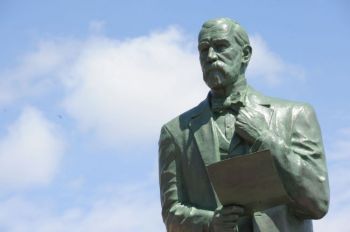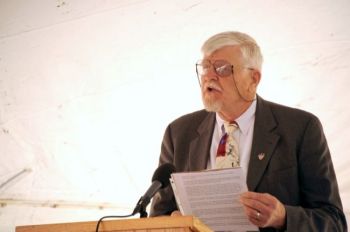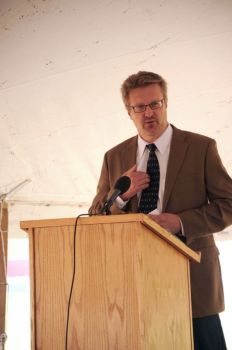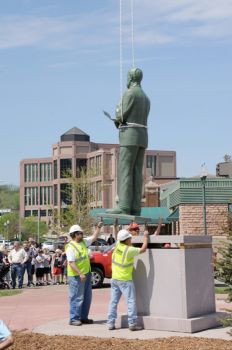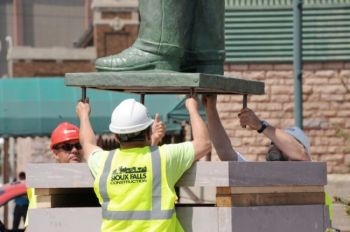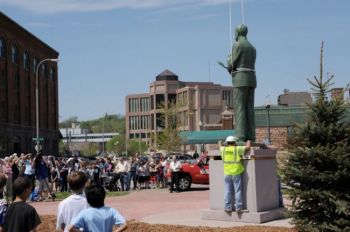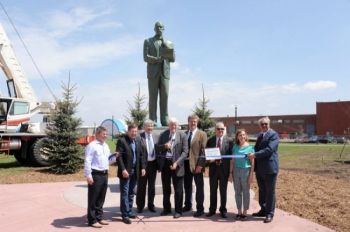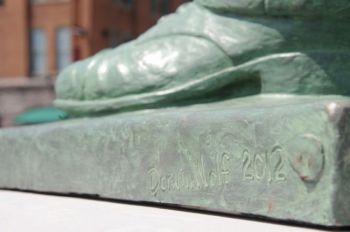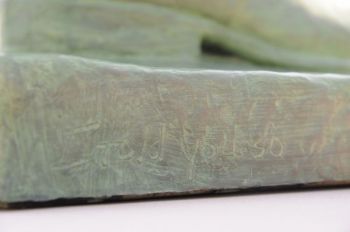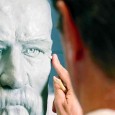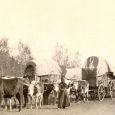The Gift of South Dakota
Subscriptions to South Dakota Magazine make great gifts!
Subscribe today — 1 year (6 issues) is just $29!
'I Told You So'
May 22, 2013
Richard Pettigrew did not leave this earth on good terms with the men who ran Sioux Falls. Despite the fact that he attracted railroads to the fledgling community on the falls of the Big Sioux River, established businesses and secured land grants, his opinions on other political matters alienated him from nearly everyone in town. When he died in 1926, the surveyor, politician, businessman and South Dakota’s first full-term senator was quickly forgotten.
But Darwin Wolf has resurrected Pettigrew. His statue of the man, a project 10 years in the making, was unveiled last week along Phillips Avenue in downtown Sioux Falls. The dedication featured kind words for Pettigrew from city officials, the presentation of a small replica to students from R.F. Pettigrew Elementary who helped raise money for the project (and who watched Wolf sculpt as part of the Artists in Schools program), and deeper reflection on the man who was part city-builder, part scoundrel.
We visited Wolf in his Sioux Falls studio in 2010, when the Pettigrew statue was still a clay head sitting atop a table. When he took the job in 2003, it began with meticulous research, just like his other projects. But the artist grew fascinated with the wily politician. “The more I learned, the more I found that I liked and disliked,” he told us. “He was such a tenacious fighter and did so many good things for Sioux Falls, the monument evolved into being a project for some redemption.”
There are countless stories of Pettigrew’s unscrupulous behavior. There’s the “Deuel County Fraud” that marred his first run for the state legislature. Pettigrew discovered that his opponent had ensured Pettigrew’s name was left off ballots circulated south of Sioux Falls. So naturally, Pettigrew omitted his opponent’s name on ballots north of town. Pettigrew was elected, but the House threw him out. “He fought fire with fire, and he was the one who got burned,” Wolf said at the dedication.
In 1870 Pettigrew and Nyrum Phillips wanted Congress to open Fort Dakota to settlement. Too few people lived within Minnehaha County to sign their petition, so they added names of men they thought would soon arrive and sent the document to Washington. He also started a stockyard and meatpacking plant along the Big Sioux River, but had no plan in place for waste removal. It was simply dumped into the river.
Chicanery aside, we cannot deny the role Pettigrew played in making Sioux Falls the urban center it is today. He brought five railroad lines to town, and got funds to build the county courthouse, post office and penitentiary. And, as Augustana College president Rob Oliver noted at the dedication, he helped secure the land grant on which the school stands today.
As U.S. Senator, many of his stances ran counter to popular opinion. He was an early advocate of women’s suffrage and opposed imperialism and America’s involvement in the Spanish-American War. He was indicted under the Espionage Act for comments disparaging President Woodrow Wilson and encouraging young soldiers to avoid fighting in World War I. His stellar legal team led by Clarence Darrow avoided prosecution, and you can still see the indictment hanging next to the Declaration of Independence inside Pettigrew’s home at the corner of Eighth and Duluth, just as it was on the day he died.
Wolf’s statue stands 10 feet tall (15 if you include the pedestal), and everything about it is meant to vindicate Pettigrew’s position on one final contentious issue. Pettigrew holds a letter in his right hand. It’s meant to be the note he penned to city leaders in the 1920s urging them to spare a piece of land near the falls from urbanization and create a park. They paid him no heed, and businesses soon moved in. Their buildings were hollow shells by the 1990s, when the city decided to remove them and spruce up the area as part of its Phillips to the Falls project.
Today Pettigrew stands at the corner of Fifth and Phillips overlooking downtown as families enjoy Falls Park behind him. If he could say anything to the leaders who occupied those downtown office buildings 100 years ago, it might be the line Wolf scratched into the base of his statue: “I told you so.”


